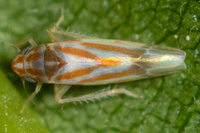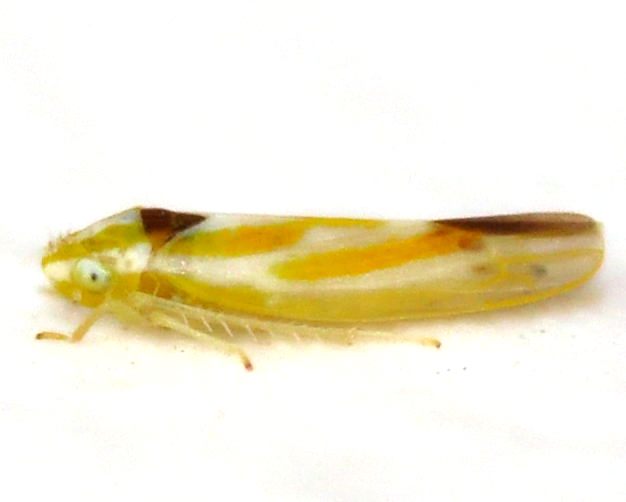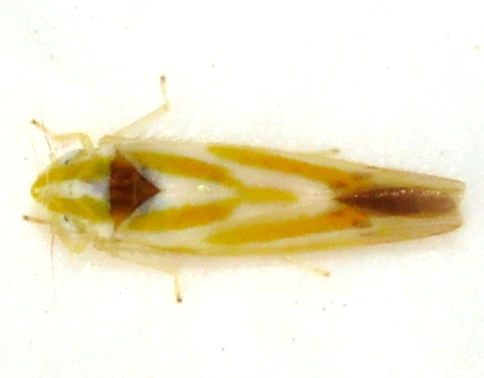
|
|
|
| synonym |
Erythridula kanensis |
| description |
A pale species with a yellow, orange, or red color pattern. The vertex has oblique lateral vittae with a pale midline. The pronotum is either dark with pale lateral margins or dark with two longitudinal orange stripes, concolorous with the wing stripes. The mesonotum varies from entirely pale, pale with dark lateral triangles on the scutellum, or entirely dark brown (note that the brown does not extend under the pronotum). In var. 'kanensis,' the scutellum is a dark brown and the upper apical cell of each wing is a hyaline brown. The anteclypeus is pale and concolorous with the rest of the face, the underside of the thorax is entirely pale; the abdomen is dark dorsally. Adults are 2.8-3.0 mm long. (3i) |
| distribution |
Eastern, central and northwestern United States, transcontinental across southern Canada (3i) |
| abundance |
Recorded from a few counties in the mountains and Piedmont, possibly more abundant in the right habitat. |
| seasonal_occurrence | |
| habitat |
Has been found in grassy, open habitat near forest; likely prefers areas near birch. |
| plant associates |
Prunus virginiana, Prunus avium (3i) |
| behavior |
Can be attracted at night with a light. |
| comments |
NOTE: Erythridula is a very challenging genus to identify to species level, as there can be variation in pattern and coloration within species, and many species resemble one another. Dissecting specimens is the the only way to determine species for many cases. This page represents individuals that are likely E. aspera, in particular var. 'kanensis' which has a dark brown scutellum and dark wing tips, a characteristic that does not seem to be shared by other Erythridula species, but until a specimen is obtained and dissected IDs on here are tentative.
This is one of several species that have a dark scutellum, and therefore it could be confused with others. These species with a dark scutellum, in order from most to least dark, are: pfrimmeri (BG), penenoeva (BG), noeva (BG), and aspera. E. pfrimmeri and penenoeva have completely dark scutellums, but in the former the scutellum is blackish whereas in the latter it tends to be a dark chestnut-brown color. Additionally, the black mesonotum is visible through the pronotum in pfrimmeri; in penenoeva, the mesonotum does not appear through as dark. E. noeva has a chestnut to reddish-brown scutellum that has dark lateral triangles, contrasting with the black scutellum of pfrimmeri, but like pfrimmeri the dark mesonotum shows through the pronotum. While the scutellum coloration may be similar between E. noeva and E. penenoeva, besides the previously stated differences in the mesonotum being visible through the pronotum, noeva seems to lack small black dots or smudges near the apical veins, whereas penenoeva can have these spots. E. aspera has a brown to dark brown scutellum, and in var. 'kanensis' the upper apical cell of each wing is dark. Finally, E. noeva has a pale abdomen dorsally, whereas the other three species have dark abdomens dorsally. |
status |
[Native:]
[Introduced:]
[Extirpated:] | | list_type |
[Official:]
[Provisional:] |
| adult_id | Unmistakable and widely known Identifiable from good quality photos of unworn specimens
Identifiable from photos showing undersides, or other specialized views [e.g., legs, face]
Identifiable only by close inspection of structural features or by DNA analysis NULL |
| nymph_id | Unmistakable and widely known Identifiable from good quality photos, especially where associated with known host plants
Identifiable from close inspection of specimens or by DNA analysis
Identifiable only through rearing to adulthood NULL |
| G_rank |
|
| S_rank |
|
| rank_comments |
|
| tribe |
Erythroneurini |
| subgenus |
|
Species Photo Gallery for Erythridula aspera No Common Name |
 | Photo by: Kyle Kittelberger, Brian Bockhahn, Paul Scharf
Avery Co.
Comment: grassy, open area with shrubby vegetation and mixed forest nearby; female |  | Photo by: Kyle Kittelberger, Brian Bockhahn, Paul Scharf
Avery Co.
Comment: grassy, open area with shrubby vegetation and mixed forest nearby; female |
 | Photo by: Kyle Kittelberger, Brian Bockhahn, Paul Scharf
Avery Co.
Comment: grassy, open area with shrubby vegetation and mixed forest nearby; female |  | Photo by: Scott Bolick
Forsyth Co.
Comment: |
 | Photo by: Scott Bolick
Forsyth Co.
Comment: |  | Photo by: Scott Bolick
Randolph Co.
Comment: |
|

 »
»


